Preliminary Structural Design of Coreless Spoiler by Topological Optimization
Abstract
1. Introduction
2. Finite Element Modelling
| Values [34] |
| Values [35] |
|---|---|---|---|
| Longitudinal Modulus, E11 | 192 GPa | Longitudinal Modulus, E11 | 1.0 MPa |
| Transverse Modulus, E22 | 10.6 GPa | Transverse Modulus, E22 | 1.0 MPa |
| Shear Modulus, G12 | 6.1 GPa | Transverse Modulus, E33 | 145 MPa |
| Shear Modulus, G13 | 3.7 GPa | Shear Modulus G12 | 44.8 MPa |
| Shear Modulus, G23 | 6.1 GPa | Shear Modulus G13 | 1.0 MPa |
| Poisson ratio, v12 | 0.4 | Shear Modulus G23 | 20.7 MPa |
| Density | 1800 kg/m3 | Poisson Ratio, v12 | 0.4 |
| Fiber Tensile Strength, F1t | 2715 MPa | Density | 49.7 kg/m3 |
| Matrix Tensile Strength, F2t | 56 MPa | ||
| Fiber Compressive Strength, F1c | 1400 MPa | ||
| Matrix Compressive Strength, F2c | 250 MPa | ||
| In-plane Shear Strength, S12 | 101 MPa | ||
| Values [34] | ||
| Young Modulus, E | 72 GPa | ||
| Poisson Ratio, v | 0.3 | ||
| Density | 1800 kg/m3 | ||
| Allowable Fatigue Stress | 110 MPa | ||
| Residual Stress | >270 MPa |
3. Structural Design Analysis
3.1. Baseline Design
3.2. Coreless Spoiler
3.3. Topological Optimization
3.4. Analysis of Parametric Optimization
4. Conclusions
Author Contributions
Funding
Institutional Review Board Statement
Informed Consent Statement
Data Availability Statement
Acknowledgments
Conflicts of Interest
References
- DeLaurier, J. Aircraft Design Concepts: An Introductory Course; CRC Press: Boca Raton, FL, USA, 2022. [Google Scholar]
- Abdi, B.; Koloor, S.S.R.; Abdullah, M.R.; Amran, A.; Yahya, M.Y. Effect of Strain-Rate on Flexural Behavior of Composite Sandwich Panel. Appl. Mech. Mater. 2012, 229–231, 766–770. [Google Scholar] [CrossRef]
- LaPlante, G.; Marble, A.E.; MacMillan, B.; Lee-Sullivan, P.; Colpitts, B.G.; Balcom, B.J. Detection of water ingress in composite sandwich structures: A magnetic resonance approach. NDT E Int. 2005, 38, 501–507. [Google Scholar] [CrossRef]
- Semple, K.E.; Sam-Brew, S.; Deng, J.; Cote, F.; Yan, N.; Chen, Z.; Smith, G.D. Properties of commercial kraft paper honeycomb furniture stock panels conditioned under 65 and 95 percent relative humidity. For. Prod. J. 2015, 65, 106–122. [Google Scholar] [CrossRef]
- Chen, Z.; Yan, N.; Deng, J.; Semple, K.E.; Sam-Brew, S.; Smith, G.D. Influence of environmental humidity and temperature on the creep behavior of sandwich panel. Int. J. Mech. Sci. 2017, 134, 216–223. [Google Scholar] [CrossRef]
- Li, C.; Ueno, R.; Lefebvre, V. Investigation of an Accelerated Moisture Removal Approach of a Composite Aircraft Control Surface; Society for the Advancement of Material and Process Engineering: Oranjewoud, The Netherlands, 2006. [Google Scholar]
- Rahman, A. Effect of nodebond failures on structural integrity of F/A 18 trailing edge flaps. In Proceedings of the 9th Joint FAA/DoD/NASA Aging Aircraft Conference, Kansas City, MO, USA, 4–7 May 2009. [Google Scholar]
- Wolff, E.G.; Chen, H.; Oakes, D.J. Moisture expansion of honeycomb sandwich panels. In Proceedings of the 30th International SAMPE Technical Conference, San Antonio, TX, USA, 20–24 October 1998. [Google Scholar]
- Charon, A. Hot/Wet Environmental Degradation of Honeycomb Sandwich Structure Representative of F/A-18: Discolouration of Cytec FM-300 Adhesive; Defence Science and Technology Organisation Melbourne (Australia): Melbourne, Australia, 2000; Technical report (DSTOTR-0908). [Google Scholar]
- Hungler, P.; Bennett, L.; Lewis, W.; Brenizer, J.; Heller, A. The use of neutron imaging for the study of honeycomb structures in aircraft. Nuclear Instruments and Methods in Physics Research Section A: Accelerators, Spectrometers. Detect. Assoc. Equip. 2009, 605, 134–137. [Google Scholar] [CrossRef]
- Tuttle, M. Moisture diffusion in honeycomb core sandwich composites. In Proceedings of the International Conference on Composite Materials, Edinburgh, Scotland, 27–31 July 2009. [Google Scholar]
- Vavilov, V.; Nesteruk, D. Evaluating water content in aviation honeycomb panels by transient IR thermography. In Thermosense XXVII; SPIE: Cardiff, Wales, 2005. [Google Scholar]
- Ibarra-Castanedo, C.; Brault, L.; Genest, M.; Farley, V.; Maldague, X. Detection and characterization of water ingress in honeycomb structures by passive and active infrared thermography using a high resolution camera. In Proceedings of the 11th International Conference on Quantitative InfraRed Thermography, Naples, Italy, 11–14 June 2012. [Google Scholar]
- Swiderski, W. Nondestructive testing of honeycomb type composites by an infrared thermography method. In Proceedings of the Proc. IV Conferencia Panamericana de END, Buenos Aires, Buenos Aires, Argentina, 22–26 October 2007. [Google Scholar]
- Vavilov, V.P.; Klimov, A.G.; Nesteruk, D.; Shiryaev, V.V. Detecting water in aviation honeycomb structures by using transient infrared thermographic NDT. In Thermosense Xxv; SPIE: Cardiff, Wales, 2003. [Google Scholar]
- Doyum, A.; Duerer, M. Defect characterization of composite honeycomb panels by non-destructive inspection methods. In Proceedings of the Proceedings DGZfP Conference Weimar, Germany, 6–8 May 2002. [Google Scholar]
- Edwards, A.K.; Savage, S.; Hungler, P.L.; Krause, T.W. Examination of F/A-18 honeycomb composite rudders for disbond due to water using through-transmission ultrasonics. Ultragarsas/Ultrasound 2011, 66, 36–44. [Google Scholar] [CrossRef][Green Version]
- Balaskó, M.; Sváb, E.; Molnár, G.; Veres, I. Classification of defects in honeycomb composite structure of helicopter rotor blades. Nuclear Instruments and Methods in Physics Research Section A: Accelerators, Spectrometers. Detect. Assoc. Equip. 2005, 542, 45–51. [Google Scholar] [CrossRef]
- Purith, P.; Kittikorn, C.; Pakpong, J.; Mezeix, L. Concept Design of a Single-Aisle Aircraft Spoiler by Topology Optimization. In IOP Conference Series: Materials Science and Engineering; IOP Publishing: Bristol, UK, 2020. [Google Scholar]
- Mei, J.; Liu, J.; Liu, J. A novel fabrication method and mechanical behavior of all-composite tetrahedral truss core sandwich panel. Compos. Part A Appl. Sci. Manuf. 2017, 102, 28–39. [Google Scholar] [CrossRef]
- Wei, K.; Yang, Q.; Ling, B.; Xie, H.; Qu, Z.; Fang, D. Mechanical responses of titanium 3D kagome lattice structure manufactured by selective laser melting. Extrem. Mech. Lett. 2018, 23, 41–48. [Google Scholar] [CrossRef]
- Liu, J.; Ou, H.; He, J.; Wen, G. Topological design of a lightweight sandwich aircraft spoiler. Materials 2019, 12, 3225. [Google Scholar] [CrossRef]
- Liu, J.; Chen, T.; Zhang, Y.; Wen, G.; Qing, Q.; Wang, H.; Sedaghati, R.; Xie, Y.M. On sound insulation of pyramidal lattice sandwich structure. Compos. Struct. 2019, 208, 385–394. [Google Scholar] [CrossRef]
- Liu, J.; Fan, X.; Wen, G.; Qing, Q.; Wang, H.; Zhao, G. A novel design framework for structures/materials with enhanced mechanical performance. Materials 2018, 11, 576. [Google Scholar] [CrossRef] [PubMed]
- Khan, M.S.; Abdul-Latif, A.; Koloor, S.S.R.; Petrů, M.; Tamin, M.N. Representative cell analysis for damage-based failure model of polymer hexagonal honeycomb structure under the out-of-plane loadings. Polymers 2020, 13, 52. [Google Scholar] [CrossRef]
- Scott, M.; Raju, J.; Cheung, A. Design and manufacture of a post-buckling co-cured composite aileron. Compos. Sci. Technol. 1998, 58, 199–210. [Google Scholar] [CrossRef]
- Kashyzadeh, K.; Koloor, S.R.; Bidgoli, M.O.; Petrů, M.; Asfarjani, A.A. An optimum fatigue design of polymer composite compressed natural gas tank using hybrid finite element-response surface methods. Polymers 2021, 13, 483. [Google Scholar] [CrossRef] [PubMed]
- McMahon, C.D.; Scott, M.L. Innovative techniques for the finite element analysis and optimisation of composites structures. In Proceedings of the 23rd International Congress of Aeronautical Sciences, Toronto, ON, Canada, 8–13 September 2002. [Google Scholar]
- Rispler, A.; Haviland, H.d.; Raju, J. Optimization of an Aircraft Control Surface. In Proceedings of the International ANSYS Conference, Pittsburgh, PA, USA, 20–24 April 2002. [Google Scholar]
- Grihon, S.; Krog, L.; Bassir, D. Numerical optimization applied to structure sizing at AIRBUS: A multi-step process. Int. J. Simul. Multidiscip. Des. Optim. 2009, 3, 432–442. [Google Scholar] [CrossRef]
- Farokhi Nejad, A.; Alipour, R.; Shokri Rad, M.; Yazid Yahya, M.; Rahimian Koloor, S.S.; Petrů, M. Using Finite Element Approach for Crashworthiness Assessment of a Polymeric Auxetic Structure Subjected to the Axial Loading. Polymers 2020, 12, 1312. [Google Scholar] [CrossRef]
- Joshani, M.; Koloor, S.S.R.; Abdullah, R. Damage Mechanics Model for Fracture Process of Steel-Concrete Composite Slabs. Appl. Mech. Mater. 2012, 165, 339–345. [Google Scholar] [CrossRef]
- Kassapoglou, C. Design and Analysis of Composite Structures: With Applications to Aerospace Structures; John Wiley & Sons: Hoboken, NJ, USA, 2013. [Google Scholar]
- Hansen, L.U.; Horst, P. Multilevel optimization in aircraft structural design evaluation. Comput. Struct. 2008, 86, 104–118. [Google Scholar] [CrossRef]
- HexWeb, Product Data: HRH-10 Aramid Fibre/Phenolic Honeycomb; H. Corporation, Editor: Dublin, Ireland, 2005; Available online: https://www.hexcel.com/ (accessed on 8 August 2022).
- Koloor, S.S.R.; Abdul-Latif, A.; Tamin, M.N. Mechanics of Composite Delamination under Flexural Loading. In Key Engineering Materials; Trans Tech Publications: Bäch, Switzerland, 2011; Volume 462–463, pp. 726–731. [Google Scholar]
- Laulusa, A.; Bauchau, O.; Choi, J.-Y.; Tan, V.; Li, L. Evaluation of some shear deformable shell elements. Int. J. Solids Struct. 2006, 43, 5033–5054. [Google Scholar] [CrossRef]
- Ostergaard, M.G.; Ibbotson, A.R.; Le Roux, O.; Prior, A.M. Virtual testing of aircraft structures. CEAS Aeronaut. J. 2011, 1, 83–103. [Google Scholar] [CrossRef]
- Schwingshackl, C.; Aglietti, G.; Cunningham, P. Determination of honeycomb material properties: Existing theories and an alternative dynamic approach. J. Aerosp. Eng. 2006, 19, 177–183. [Google Scholar] [CrossRef]
- Barton, A.B. Integrating Manufacturing Issues into Structural Optimization. Ph.D Thesis, The University of Sydney, Sydney, Australia, 2002. [Google Scholar]
- Koloor, S.; Ayatollahi, M.; Tamin, M. Elastic-damage deformation response of fiber-reinforced polymer composite laminates with lamina interfaces. J. Reinf. Plast. Compos. 2017, 36, 832–849. [Google Scholar] [CrossRef]
- Lomax, T.L. Structural Loads Analysis for Commercial Transport Aircraft: Theory and Practice; American Institute of Aeronautics and Astronautics: Reston, VA, USA, 1996. [Google Scholar]
- Koloor, S.S.R.; Karimzadeh, A.; Tamin, M.N.; Shukor, M.H.A. Effects of Sample and Indenter Configurations of Nanoindentation Experiment on the Mechanical Behavior and Properties of Ductile Materials. Metals 2018, 8, 421. [Google Scholar] [CrossRef]
- Alipour, R.; Alipour, R.; Fardian, F.; Koloor, S.S.R.; Petrů, M. Performance improvement of a new proposed Savonius hydrokinetic turbine: A numerical investigation. Energy Rep. 2020, 6, 3051–3066. [Google Scholar] [CrossRef]
- Ness, R.; Wang, J.; Kelly, D.; Reju, J.; Barton, A.; Lindsay, A. Conceptual Design of a Wing Spoiler; Tech. Rep, CRC-ACS CP 980111998; Cooperative Research Centre for Advanced Composite Structures: Melbourne, Australia, 1998. [Google Scholar]
- Lencus, A.; Querin, O.M.; Steven, G.P.; Xie, Y.M. Modifications to the evolutionary structural optimisation (ESO) method to support configurational optimisation. In Proceedings of the 3rd World Congress of Structural and Multidisciplinary Optimization, New York, NY, USA, 17–21 May 1999. [Google Scholar]


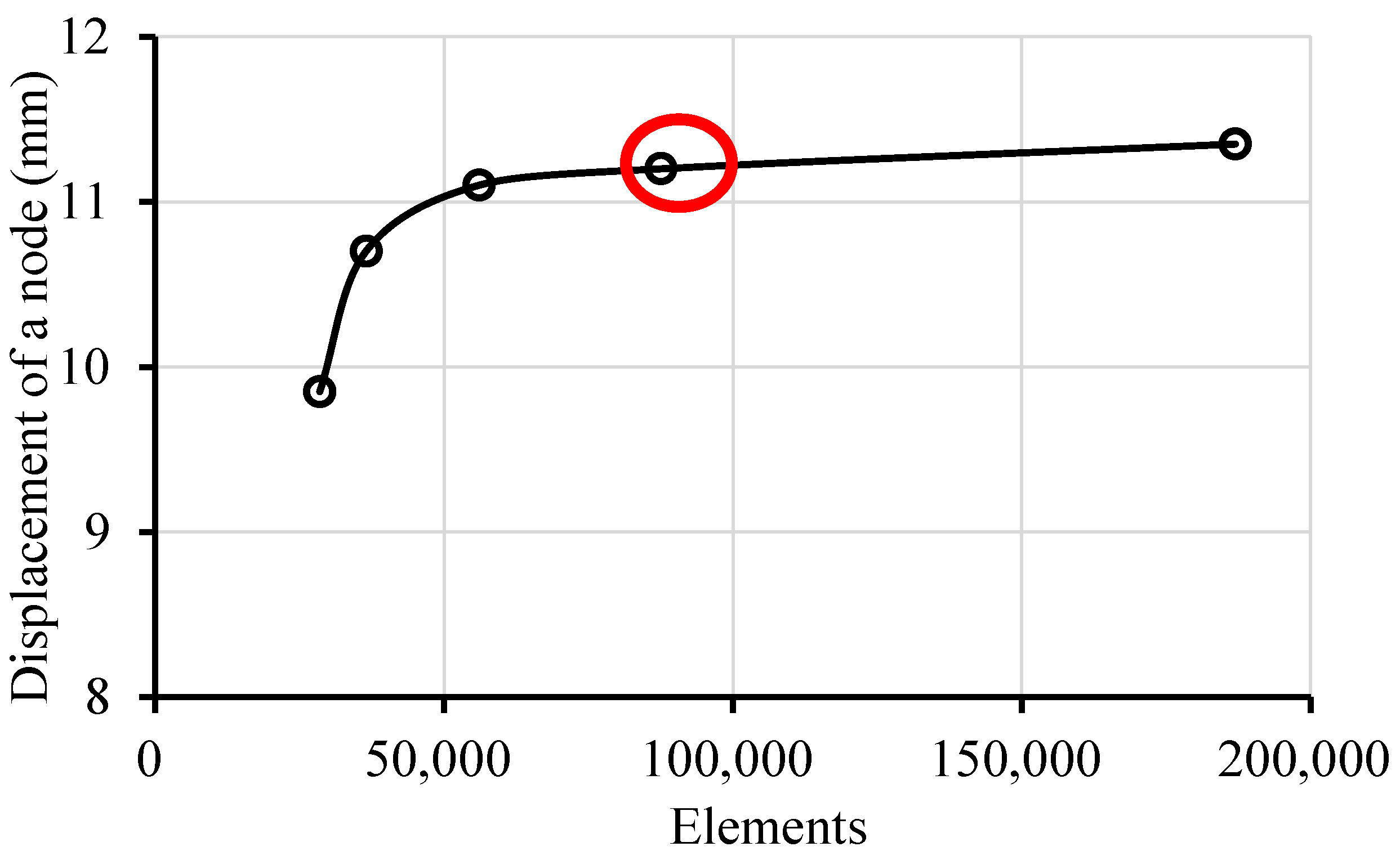
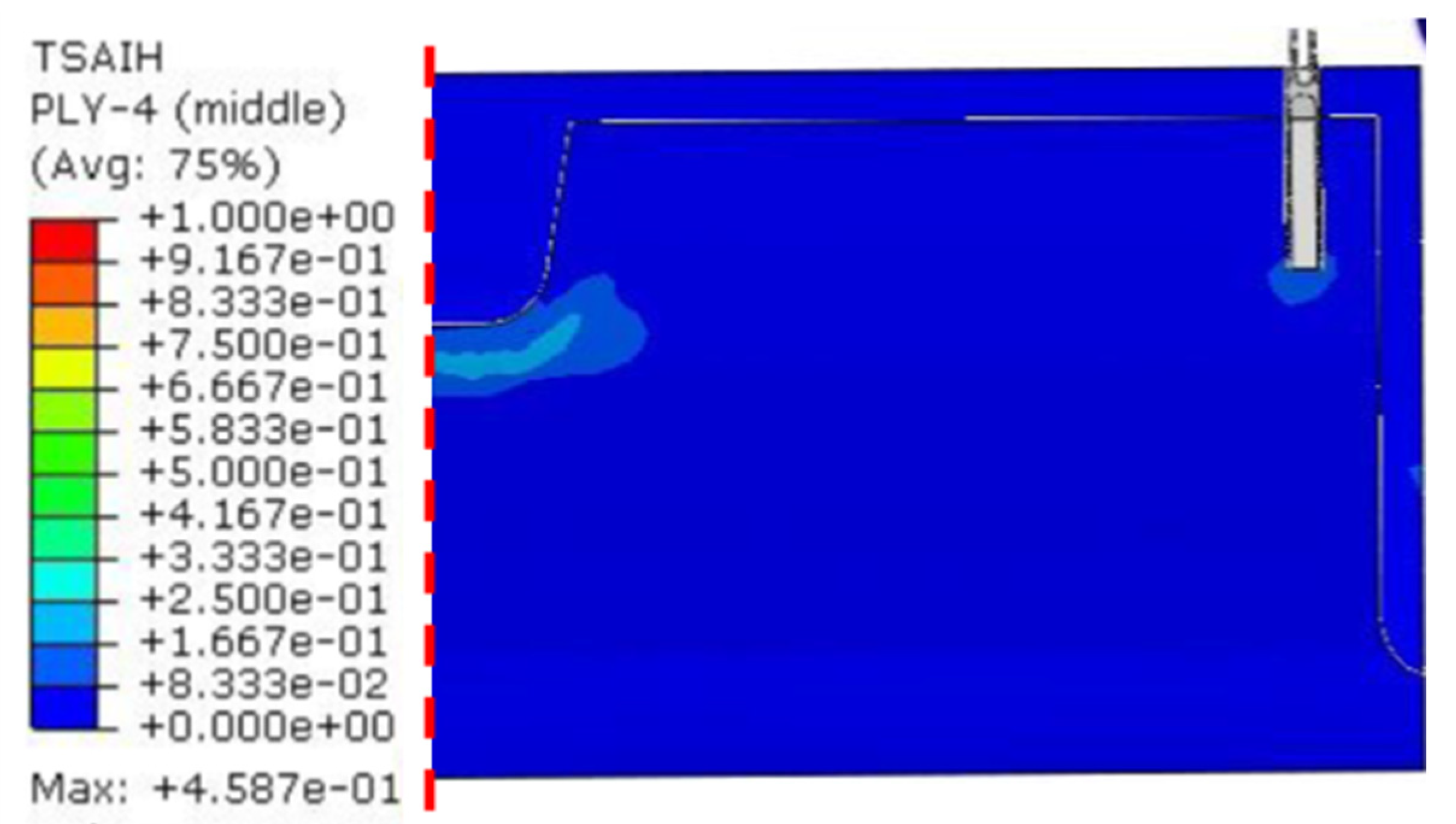
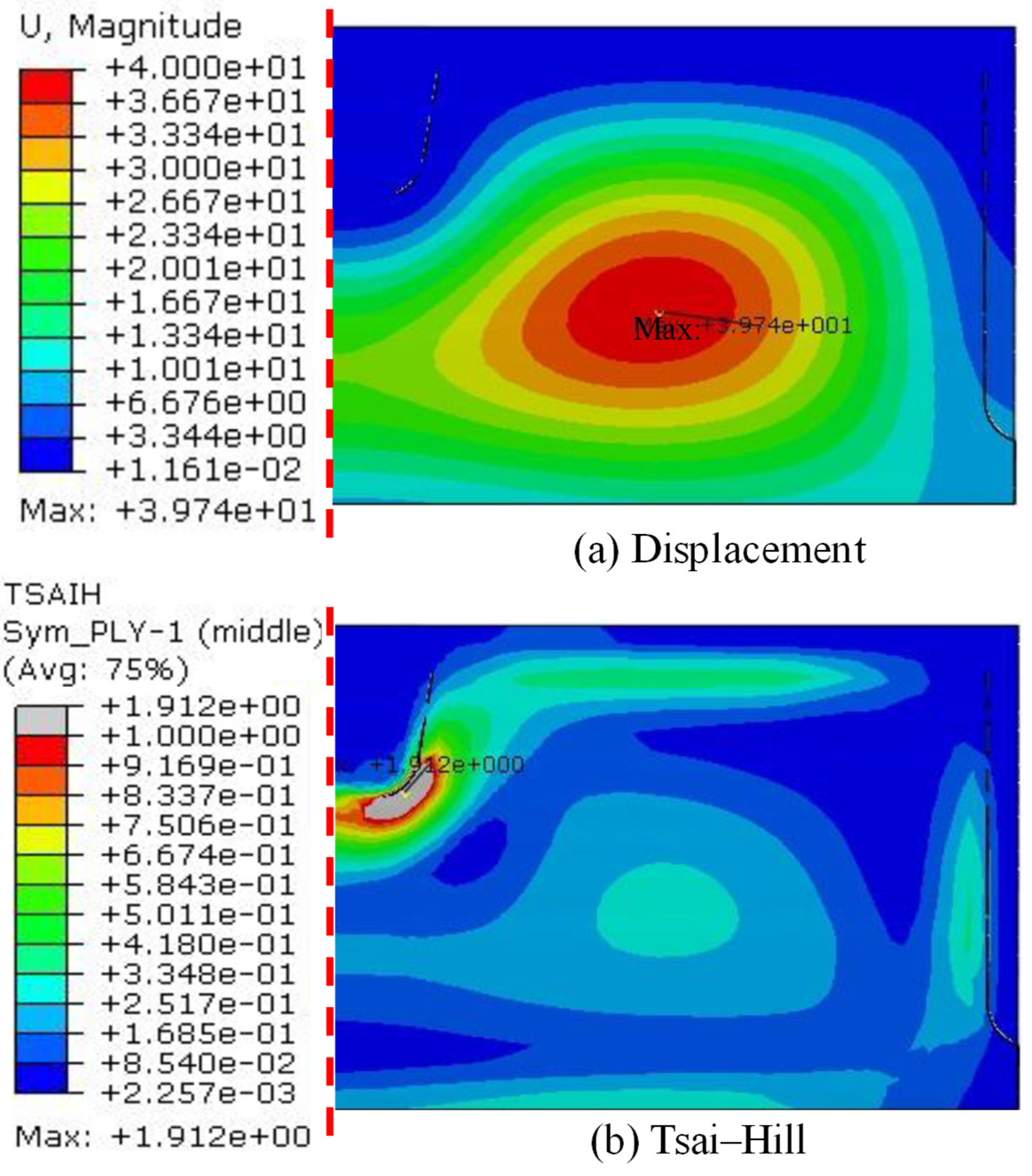

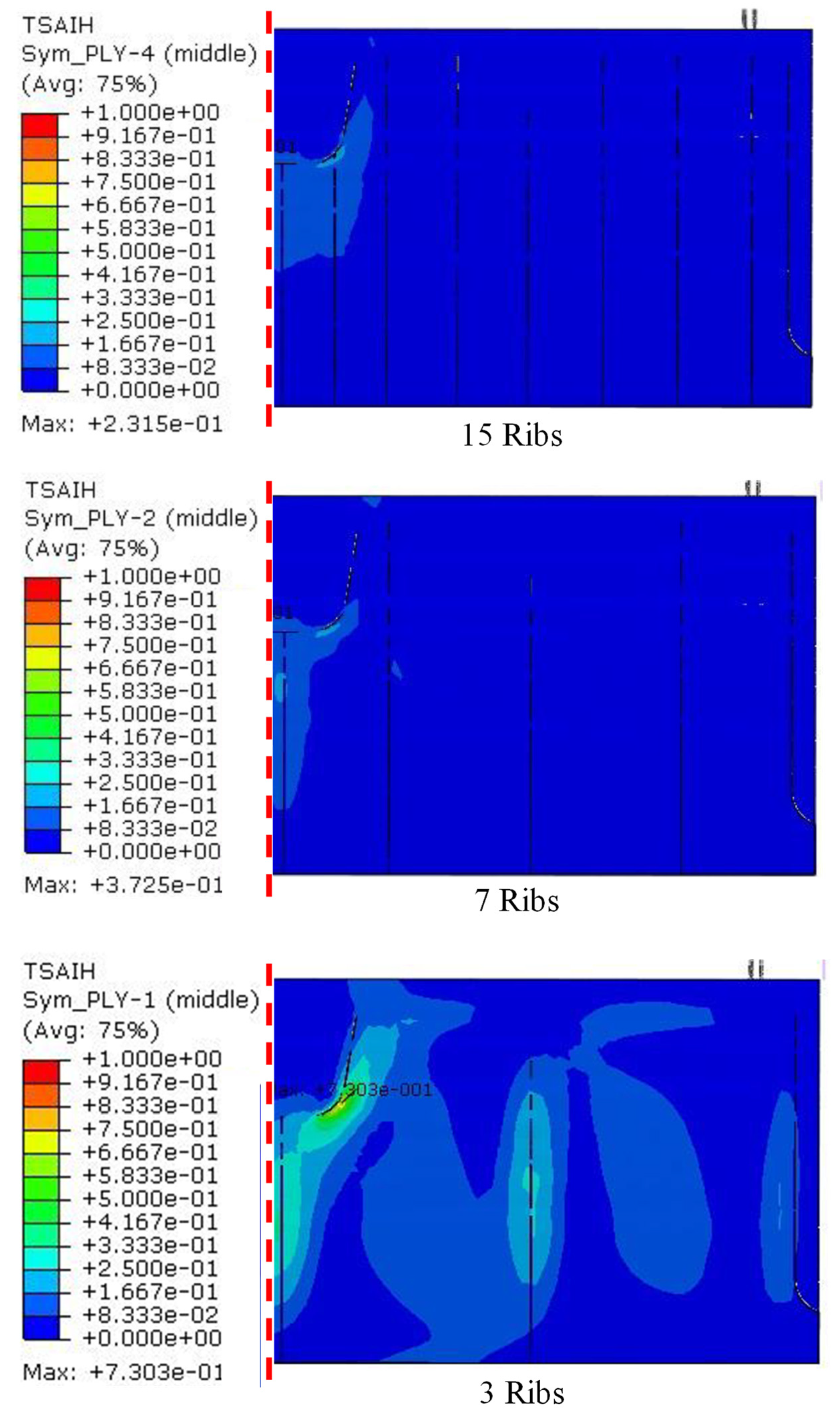

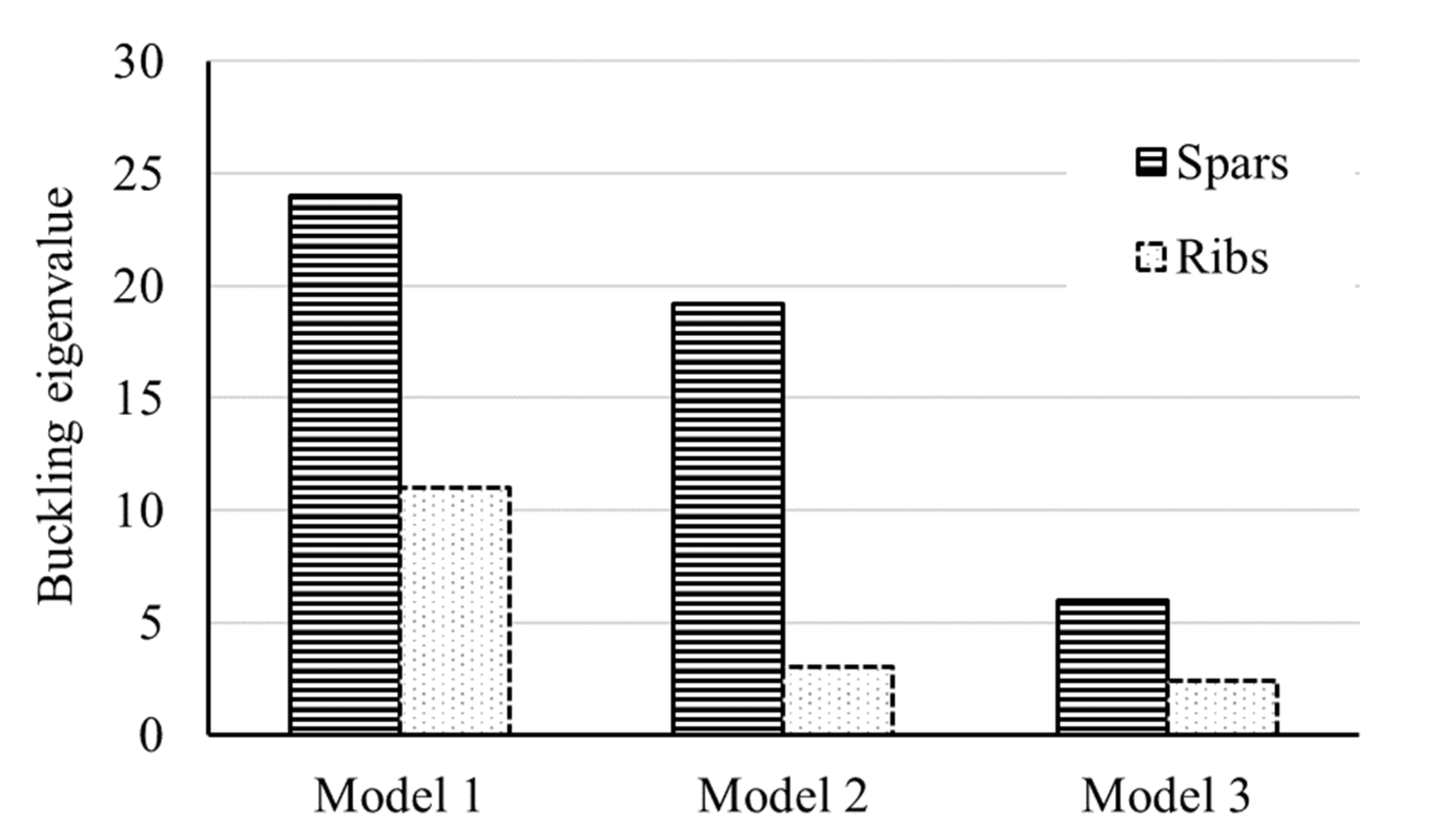




Publisher’s Note: MDPI stays neutral with regard to jurisdictional claims in published maps and institutional affiliations. |
© 2022 by the authors. Licensee MDPI, Basel, Switzerland. This article is an open access article distributed under the terms and conditions of the Creative Commons Attribution (CC BY) license (https://creativecommons.org/licenses/by/4.0/).
Share and Cite
Israr, H.A.; Chwen, T.S.; Latif, A.A.; Wong, K.J.; Rahimian Koloor, S.S.; Yidris, N.; Yahya, M.Y. Preliminary Structural Design of Coreless Spoiler by Topological Optimization. Processes 2022, 10, 2076. https://doi.org/10.3390/pr10102076
Israr HA, Chwen TS, Latif AA, Wong KJ, Rahimian Koloor SS, Yidris N, Yahya MY. Preliminary Structural Design of Coreless Spoiler by Topological Optimization. Processes. 2022; 10(10):2076. https://doi.org/10.3390/pr10102076
Chicago/Turabian StyleIsrar, Haris Ahmad, Teh Soo Chwen, Ainullotfi Abd. Latif, King Jye Wong, Seyed Saeid Rahimian Koloor, Noorfaizal Yidris, and Mohd Yazid Yahya. 2022. "Preliminary Structural Design of Coreless Spoiler by Topological Optimization" Processes 10, no. 10: 2076. https://doi.org/10.3390/pr10102076
APA StyleIsrar, H. A., Chwen, T. S., Latif, A. A., Wong, K. J., Rahimian Koloor, S. S., Yidris, N., & Yahya, M. Y. (2022). Preliminary Structural Design of Coreless Spoiler by Topological Optimization. Processes, 10(10), 2076. https://doi.org/10.3390/pr10102076








